Don’t Hate Your Job
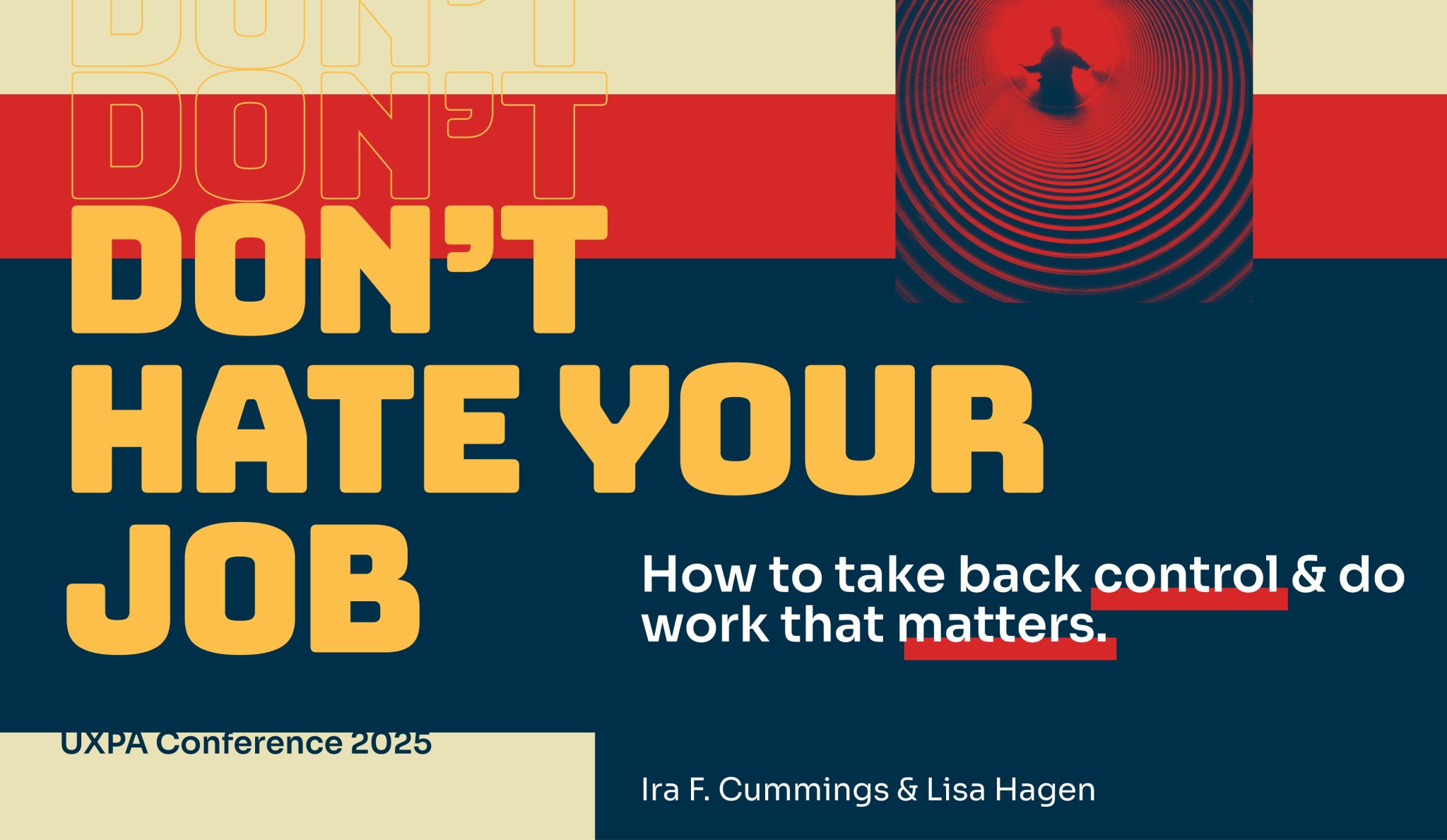
Taking back control of your work, your relationships, and your career
Across industries and roles, we’ve been seeing the same patterns show up again and again. Teams are being asked to do more with less, and then somehow still deliver faster. Product and UX teams are under growing pressure to create value—but often without the space, time, or support to actually figure out what valuable looks like. The creative work required to explore and discover meaningful solutions is being crowded out by an endless push to deliver.
At the same time, many companies lack a clear understanding of what great product teams actually look like in practice. There’s confusion about roles, misalignment on decision-making, and a reactive approach to planning that keeps teams stuck in delivery mode. The people doing the work—people who care deeply about building thoughtful, customer-centered products—are burning out trying to make it all work inside a system that doesn’t give them much to work with. And they’re not alone. As this recent article in Lenny’s Newsletter highlights, burnout has become a critical issue across the tech industry.
I’ve been there myself.
There were times when I thought I was doing everything right—showing up, advocating for users, trying to hold the line on quality. But underneath it, I was frustrated. Drained. Constantly reacting to shifting priorities. And I didn’t realize how much my own outlook was shaping how I moved through that environment.
What changed wasn’t the system. It was how I chose to show up inside it.
That’s what led Ira Cummings and me to pitch the “Don’t Hate Your Job: How to Take Back Control & Do Work That Matters” talk to UXPA Boston.
I’m especially grateful to Ira—not just for co-leading this conversation, but for the thoughtful, beautiful design work that made the ideas land. It was a true collaboration on a topic that matters deeply to both of us.
We didn’t want to introduce another framework. We wanted to talk about what it’s like when your job becomes a treadmill of delivery—and quitting isn’t the answer, but staying stuck isn’t working either.
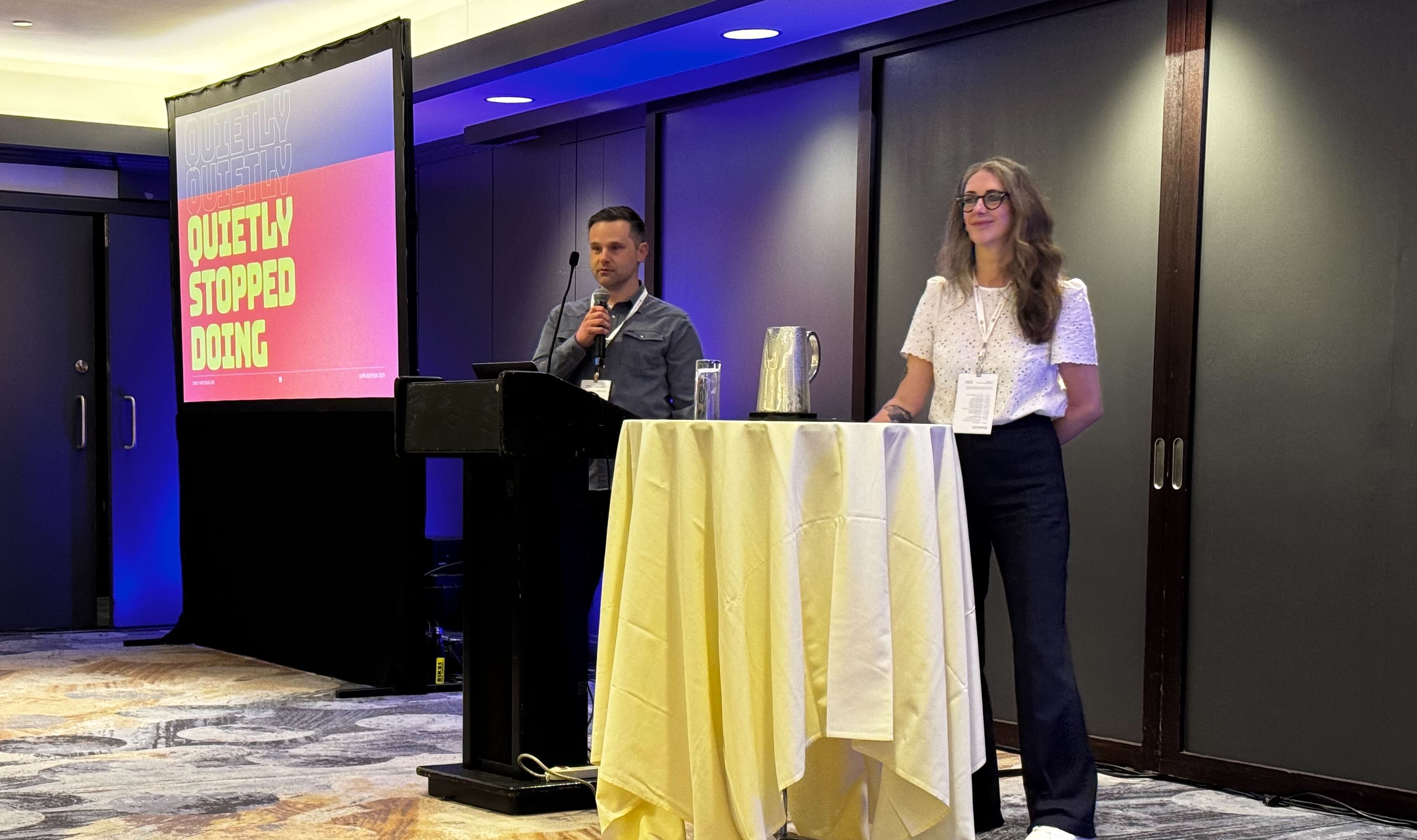
It struck a chord. People stayed after—not to talk frameworks, but to talk about what they’re really dealing with at work.
We shared three places to start—small shifts you can make so you can find your way back to doing work you care about, without losing yourself in the process.
But First, How Did We Get Here
The delivery grind
Shipping has become the goal. Teams are celebrated for velocity, not impact. Planning cycles are compressed. “Done” means released, not necessarily successful.
I remember one quarter where we were deep in report-outs—status updates, roadmap reviews, planning the next cycle. But when someone asked what outcomes we’d actually achieved, I realized… I didn’t have a good answer. We’d shipped a lot, but I wasn’t sure if we were making real progress for the customer. It’s so easy to get bogged down in the work about the work and lose sight of whether we’re focused on the right things—and whether they’re actually making a difference.
Process backlash
Agile, OKRs, design sprints—each introduced with good intent, but layered without reflection. Many teams now feel stuck in process for the sake of process, performing collaboration instead of doing the real thing.
Unclear value
Without a clear sense of what success looks like—or how product and UX work connect to business goals—teams fall back on outputs. The result: features get built, research gets run, but the core problems remain unsolved.
These aren’t isolated issues. They’re the result of systems that haven’t evolved to support how modern product teams actually need to work.
These challenges are big—but the changes don’t have to be.
Here are three practical ways to start shifting your experience
at work, even if everything around you stays the same.
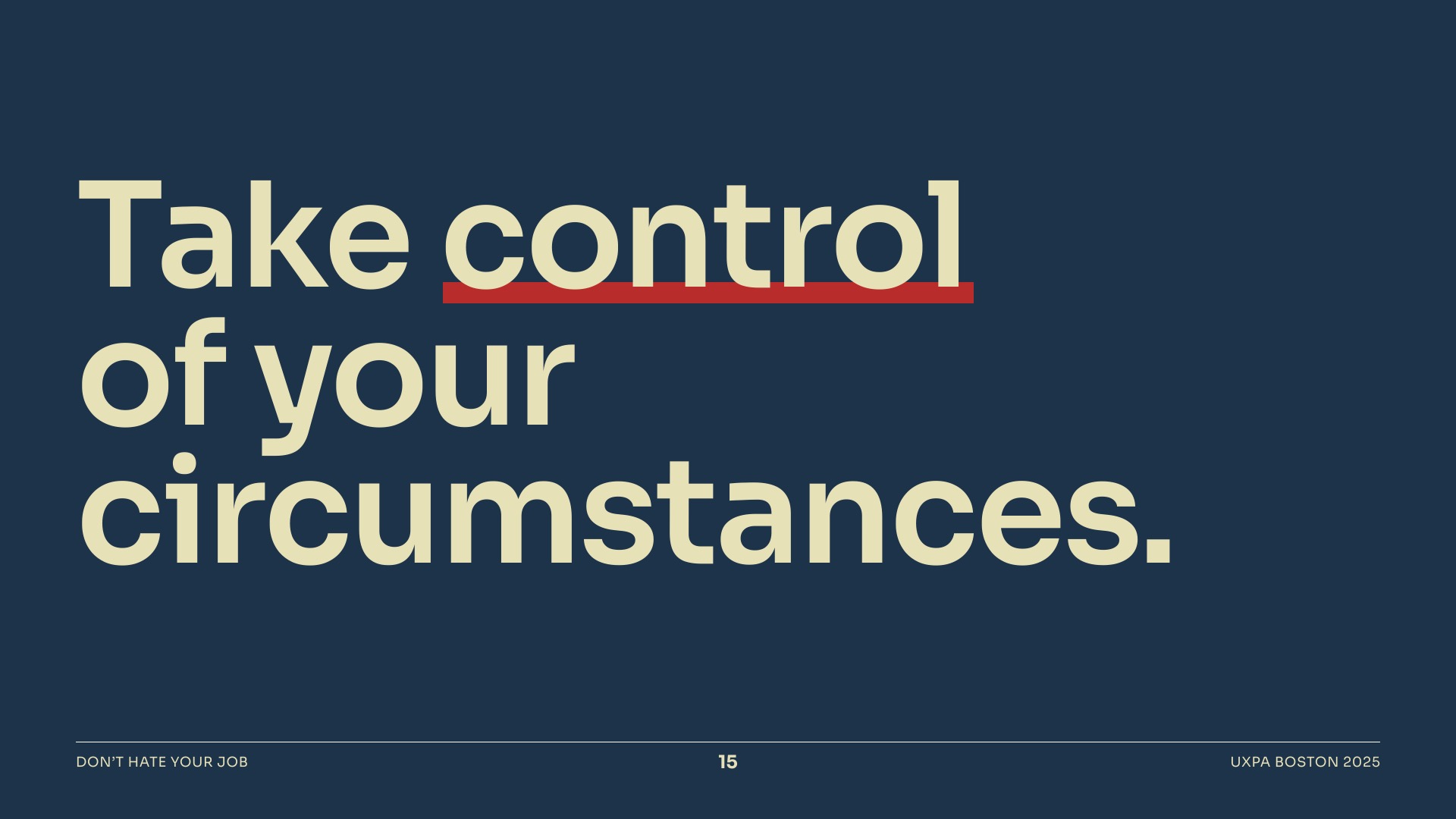
1. Work: Do Less to Do More
When things start to feel stuck, the instinct is to do more. More research. More alignment meetings. More documentation. But often, what’s needed isn’t more effort—it’s better focus.
Doing less doesn’t mean caring less. It means spending your energy where it matters most.
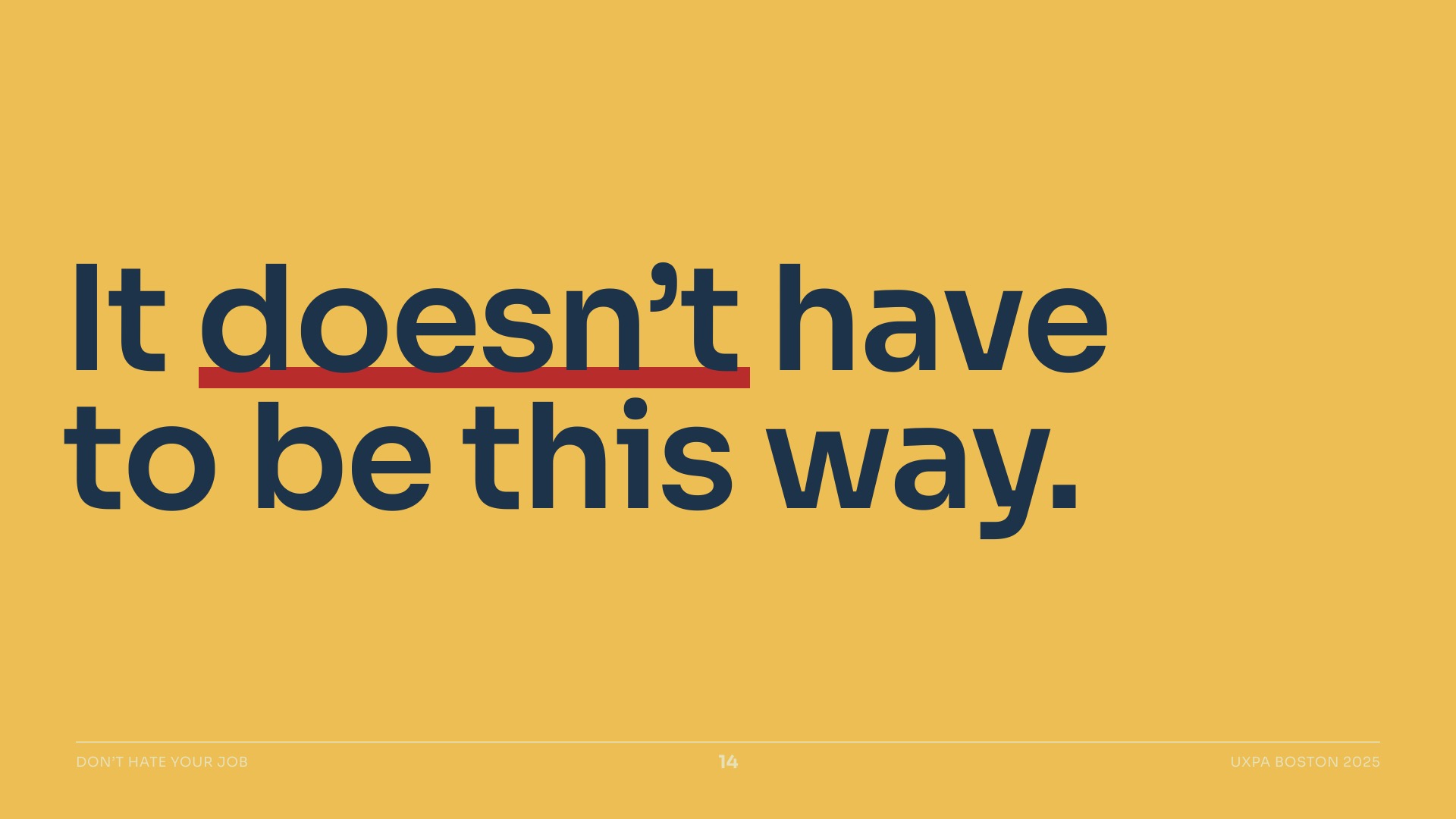
That might look like:
- Letting go of work that’s not creating leverage or momentum
- Building just enough structure to support better decisions without adding unnecessary process
- Creating a shared vision that’s small enough to start and strong enough to guide
When you give yourself and your team permission to stop doing the things that don’t serve the outcome, you create space for the creative, strategic, and collaborative work that actually moves things forward.
I remember the moment a designer on our team asked, “Do we actually need to do all of this?” We were overcommitting every sprint, constantly playing catch-up, and feeling defeated. That one question helped us rethink what we were prioritizing—and why.
2. People: How You Show Up Matters
It’s common to feel like you’re not being included early enough—or that decisions are being made without your input. But one of the biggest shifts we can make is in how we show up in those moments.
Many product and UX professionals operate in advocate mode: defending their work, explaining their process, asking for a seat at the table. It’s understandable—but it’s rarely effective.

Shifting into partner mode is where the real change happens. It’s not about playing politics or holding back your expertise—it’s about meeting people where they are, so you can move forward together.
That might mean dropping words that don’t connect and finding clearer ways to say what you mean. I stopped saying “discovery” and started talking about how we were de-risking our bets—what we needed to learn to avoid wasted effort. In roadmap meetings, I came prepared to talk trade-offs: “If we go with this now, here’s what we’re pushing back.” And when I shared research plans, I focused on what decisions the work would support—like whether a problem was widespread enough to prioritize—not just the steps we’d take to get there.
There was a time when a top consulting firm came in to help define the roadmap for the very products I was managing—and I wasn’t even invited to the meetings. It stung. But instead of sitting in that frustration, I got to work. I put together a clear plan, grounded in what I knew from our customers and delivery realities. This time, though, I made sure it spoke their language. I asked better questions about the business goals and framed my recommendations around those. Then I walked my boss through it. I didn’t wait to be brought in—I pulled up my own chair to the table.
That’s the shift.
That doesn’t mean being agreeable or stepping back. It means:
- Speaking in the language of the goals we want to achieve, and using words that are clear to everyone
- Framing your work in terms others care about (business risks, customer behavior, growth opportunities)
- Sharing trade-offs early and often, not just polished solutions
- Building trust through consistency and clarity, not defensiveness
Influence doesn’t come from asking for it. It comes from showing up in a way that helps others make better decisions—together.
3. Career: Zoom Out, Design What Comes Next
When everything feels reactive, it’s easy to stay in survival mode. You get through the week, ship the work, and start over on Monday.
But real career growth—and real satisfaction—requires stepping back.
Designing your career doesn’t mean making a five-year plan. It means creating enough distance to see clearly and make intentional choices.
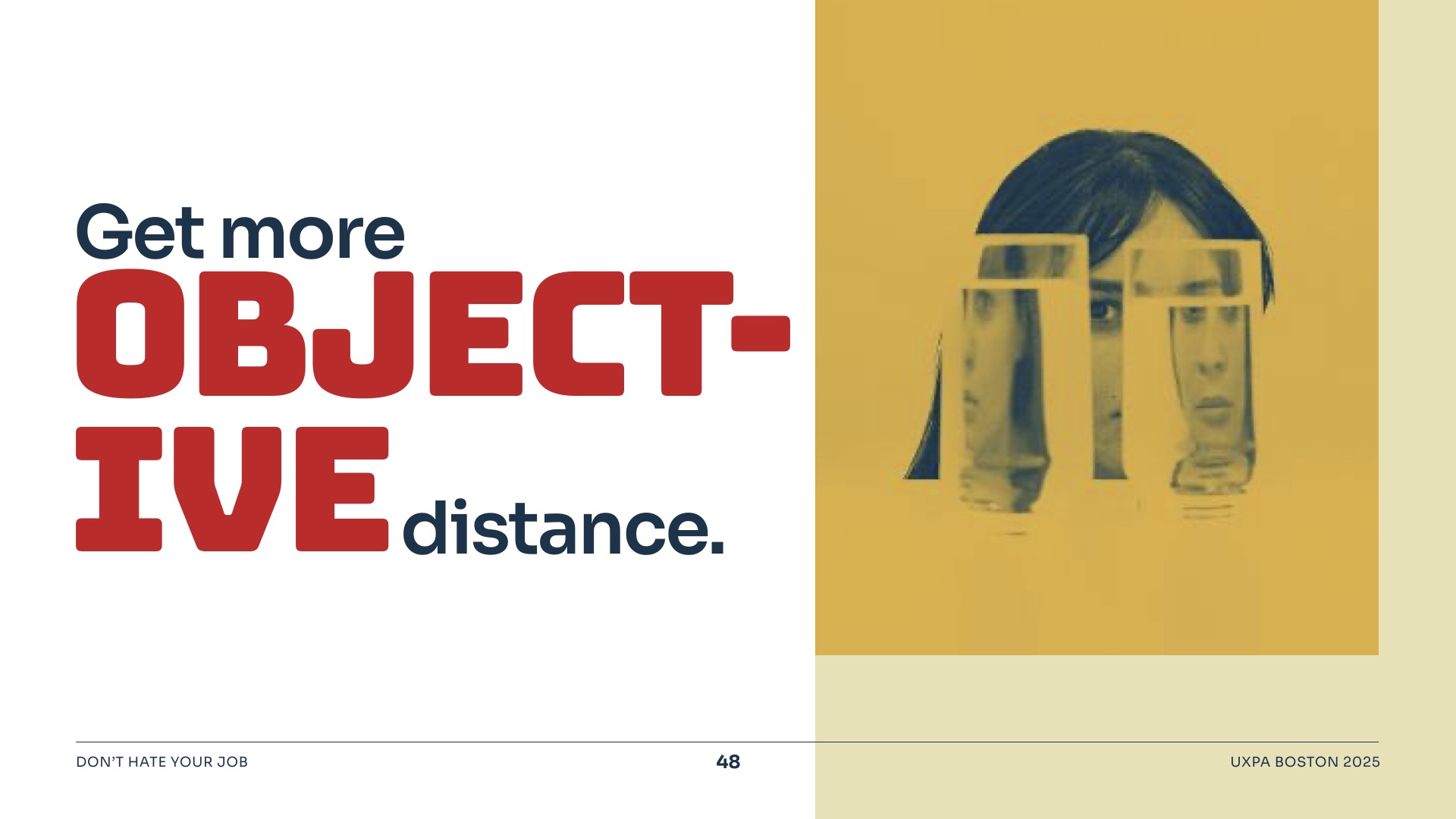
That might mean:
- Putting reflective practices in place so you’re not just reacting to the latest fire
- Saying yes to the projects that energize you—and no to the ones that drain you
- Finding a clearer narrative for your role, so others (and you) understand what you’re actually there to do
What helped me most wasn’t a promotion or a new role—it was getting a bit of distance. I went to a conference, and just talking with other product leaders made me realize: this wasn’t just me. The friction, the burnout, the unclear impact—it was happening everywhere. That perspective helped me stop internalizing it all and start making more deliberate choices about what I said yes to.
The environment may be messy or broken. But when you reconnect with what gives you energy and start designing from that place, you start to build a version of your job—and your path—that feels more sustainable.
You Don’t Need a New Job
This isn’t a call to quit. It’s a call to shift.
To shift how you work.
How you show up.
How you design your next move—even inside constraints you don’t control.
If this resonates, start with one small shift this week.
Reframe a conversation. Say no to something that doesn’t move the work forward.
Take 30 minutes to step back and ask: What’s actually worth doing?
And if you’re a leader reading this, here’s the part we can’t ignore:
A lot of the reasons people hate their jobs are systemic. These aren’t personal problems—they’re structural problems. And the solution isn’t asking individuals to do better—it’s building environments where great work is actually possible.
That’s the work I do with companies. We help product and technology leaders get to the root of what’s slowing their teams down—whether it’s misaligned goals, lack of clarity, or teams stuck in endless delivery. Together, we identify what needs to shift, and then work alongside your team to build the habits, structures, and systems that support real traction. Teams get back to doing the work they care about.
If you’re feeling stuck or just need help seeing a path forward, ping me. Always happy to chat.
And if you're navigating complexity on the design side—or trying to help your team work more effectively across silos—my co-presenter Ira Cummings is someone I often collaborate with. He brings deep experience as a designer, facilitator, and systems thinker, helping teams co-design better ways of working and move through change with clarity and connection. You can learn more about his work at iracummings.com.
